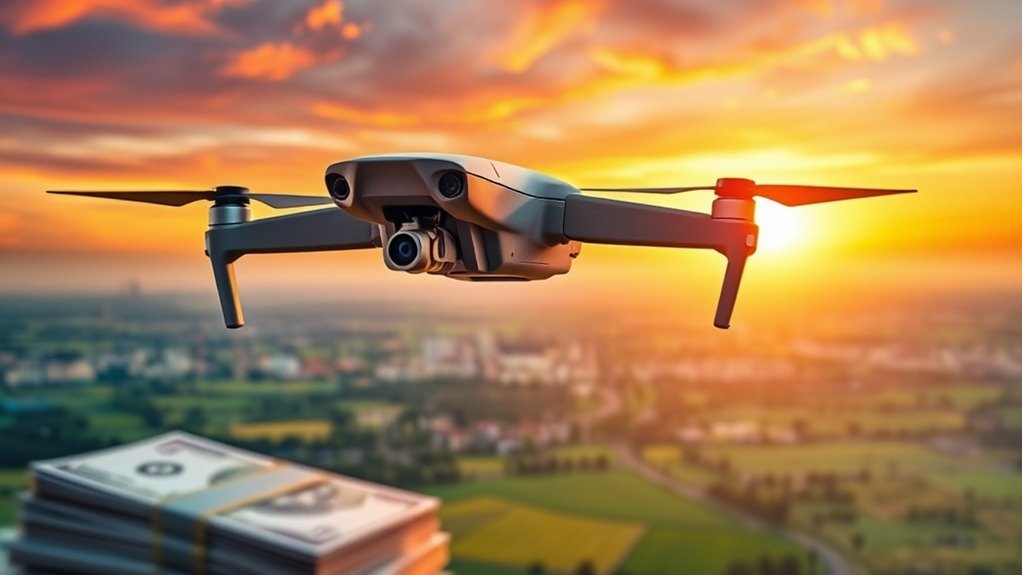By 2025, you can expect drone pilots to earn between $40,000 and $100,000 annually. This salary range is influenced by factors such as industry specialization, experience level, certification, and geographic location. Entry-level positions generally start lower, while seasoned professionals in high-demand sectors can command considerably more. Urban areas may offer higher salaries due to increased project complexity. Understanding these dynamics can guide your career choices; explore further to uncover opportunities for maximizing your earning potential.
Overview of the Drone Pilot Job Market

As the demand for drone services continues to expand across various industries, it’s essential to understand the current job market for drone pilots. The rapid evolution of drone technology has created numerous opportunities, with sectors like agriculture, real estate, and cinematography leading the way. Pilot training programs are increasingly being tailored to meet these industry needs, ensuring you acquire the necessary skills to operate sophisticated UAVs effectively. According to recent data, the job market is projected to grow by over 30% in the next few years, reflecting a strong appetite for skilled pilots. This surge highlights the importance of staying updated on regulatory changes and technological advancements to maximize your potential in this dynamic field. Embrace the freedom this career path offers.
Projected Salary Ranges for Drone Pilots

As you explore the projected salary ranges for drone pilots, it’s crucial to take into account industry demand trends that influence compensation. Geographic salary variations also play a significant role, as pilots in urban areas often earn more than those in rural regions. Understanding these factors can help you gauge potential earnings in this evolving field.
Industry Demand Trends
Although the demand for drone pilots continues to rise across various industries, understanding the projected salary ranges is essential for those considering this career path. As emerging technologies and regulatory changes advance, the salary range for drone pilots is expected to reflect this growth. Here are three key trends influencing compensation:
- Experience Level: Entry-level pilots may earn between $40,000 and $60,000, while seasoned professionals can command $100,000 or more.
- Industry Demand: Sectors like agriculture, real estate, and construction consistently seek skilled pilots, driving salaries upward.
- Certification Impact: Pilots with specialized certifications often enjoy higher salaries due to increased demand for advanced skills.
Geographic Salary Variations
Geographic location plays an essential role in determining salary ranges for drone pilots, with significant variations evident across different regions. You’ll likely notice salary disparities based on local demand for drone services. For instance, urban areas with high construction and film production demands tend to offer higher salaries, often exceeding $85,000 annually. Conversely, rural regions may see averages closer to $50,000, reflecting lower regional demand. States with booming tech sectors, like California and Texas, typically provide the most lucrative opportunities. Understanding these geographic influences can help you make informed decisions about where to focus your career. As the industry evolves, adapting to these regional trends will be key in maximizing your earning potential as a drone pilot.
Factors Influencing Drone Pilot Earnings

While various elements play a role in determining drone pilot earnings, key factors include experience level, industry specialization, and geographic location. Understanding these can help you gauge your potential income in this evolving field.
- Experience Level: More years in the field often translate to higher pay, especially with advanced pilot training in drone technology.
- Industry Specialization: Pilots in sectors like agriculture or cinematography may command different rates based on demand and expertise.
- Geographic Location: Urban areas typically offer higher salaries due to demand, but living costs can offset these benefits.
Industry-Specific Salary Variations
When you’re considering a career as a drone pilot, it’s essential to recognize how salary varies across different industries. For instance, pilots in agriculture often earn less than those in film and photography, while surveying and mapping can offer competitive rates. Understanding these industry-specific salary variations can help you make informed decisions about your career path.
Agriculture Sector Earnings
Although the earnings of drone pilots can vary markedly across different sectors, those operating in agriculture often experience unique financial dynamics influenced by the industry’s specific needs. As drone technology continues to advance, agricultural applications provide lucrative opportunities. Here are three key factors impacting earnings in this sector:
- Crop Monitoring: Pilots can earn between $50,000 to $80,000 annually by providing aerial data for crop health assessments.
- Precision Agriculture: Utilizing drones for precision farming can boost earnings up to $100,000, driven by demand for high-quality produce.
- Data Analysis: Offering analytical insights from drone data can add another $20,000, showcasing the value of skilled interpretation in agricultural practices.
Film and Photography Pay
In the film and photography industry, drone pilots can expect to earn salaries ranging from $30,000 to over $100,000, depending largely on their experience and the complexity of the projects they undertake. Those who master advanced drone cinematography techniques often command higher rates, as they can deliver unique perspectives that enhance visual storytelling. Aerial photography trends reveal a growing demand for high-quality footage, especially in commercial sectors like real estate and advertising. Pilots utilizing cutting-edge technology and creative skills are likely to stand out and attract more lucrative opportunities. Ultimately, your earning potential hinges on your ability to adapt to evolving industry standards and continuously refine your skill set to meet the market’s demands.
Surveying and Mapping Rates
As the demand for accurate and efficient data collection increases, drone pilots specializing in surveying and mapping can expect compensation that varies greatly based on factors such as location, experience, and the specific services offered. Here’s a breakdown of key factors influencing your earnings:
- Location: Urban areas typically offer higher pay due to increased project complexity and demand for surveying techniques.
- Experience: Experienced pilots with advanced skills in mapping technologies can command premium rates.
- Service Scope: Offering specialized services, like aerial topography or land surveying, can greatly boost your income potential.
With the right blend of these elements, you can position yourself for success in this evolving field, maximizing your financial freedom as a drone pilot.
Geographic Location and Its Impact on Income
While the demand for drone pilots continues to grow, geographic location plays an essential role in determining their income levels. Generally, urban areas offer higher pay due to increased demand and numerous industries utilizing drone technology, such as real estate and agriculture. However, you must also consider the cost of living; higher salaries in cities can be offset by elevated living expenses. In contrast, rural regions often see lower pay but also lower living costs, which can create a balanced financial scenario. Ultimately, your choice of location impacts not just your potential earnings but also your overall financial freedom, making it vital to weigh the benefits of urban vs rural opportunities in your decision-making process.
The Role of Experience and Certification
Geographic location influences not only the income of drone pilots but also the value of their experience and certification. As you consider entering this field, understanding the impact of your credentials is essential. Here are three key factors to think about:
- Experience Levels: Entry-level pilots earn less, while those with several years of experience can command higher salaries due to proven skills. Asylon’s software enhances operational efficiency by automating routine processes, which can be beneficial for pilots looking to streamline their workflow.
- Certification Types: Specialized certifications (like Part 107) can greatly enhance your marketability and income potential.
- Industry Demand: Certain sectors, like agriculture or construction, may pay more for pilots with specific certifications and experience, reflecting their needs. Additionally, pilots trained in advanced camera capabilities can offer unique services that set them apart in competitive markets.
Ultimately, your earning potential is closely tied to how you leverage your experience and certification in a competitive landscape.
Future Growth Opportunities for Drone Pilots
Given the rapid advancements in drone technology and expanding applications across various industries, future growth opportunities for drone pilots are promising. The integration of emerging technologies like AI and machine learning will enhance operational efficiency, creating demand for skilled pilots who can navigate complex tasks. Additionally, regulatory changes are anticipated to streamline drone operations, particularly in commercial sectors such as agriculture, real estate, and logistics. As industries increasingly adopt drones for data collection, surveillance, and delivery, you’ll find that specialized training and certifications will further elevate your marketability. The combination of technological innovation and evolving regulations positions you to capitalize on new roles, allowing for greater autonomy and career growth in this dynamic field. Furthermore, the rise of AI-driven analytics in various sectors will further enhance the operational capabilities of drone pilots, making their roles even more critical. This includes leveraging advanced drone technology to support diverse environmental studies and assessments.
Frequently Asked Questions
What Qualifications Do I Need to Become a Drone Pilot?
To become a drone pilot, you’ll need commercial drone certifications and proper drone pilot training. These credentials guarantee you understand regulations, safety protocols, and operational techniques, providing you the freedom to explore various aerial applications.
Are There Any Age Restrictions for Becoming a Drone Pilot?
So, you think you can just hop on a drone at any age? Sadly, age requirements and legal regulations exist. Generally, you’ve gotta be at least 16 for a pilot certificate. Freedom’s got its rules!
Can Drone Pilots Work Remotely or Freelance?
Yes, you can work remotely as a drone pilot, leveraging remote operations for various projects. Freelance opportunities abound, allowing you to choose clients and schedules that fit your lifestyle, maximizing your freedom and flexibility.
What Types of Drones Are Most Commonly Used in Commercial Work?
You won’t believe how essential drones are in various commercial sectors! Agricultural drones, delivery drones, surveying drones, inspection drones, and aerial photography drones dominate the market, each serving specific needs and expanding opportunities for pilots.
How Can Drone Pilots Improve Their Earning Potential?
To improve your earning potential, consider obtaining advanced certifications and targeting niche markets. Specializing in areas like aerial surveying or agricultural monitoring can greatly enhance your marketability and lead to higher-paying opportunities in the drone industry.

